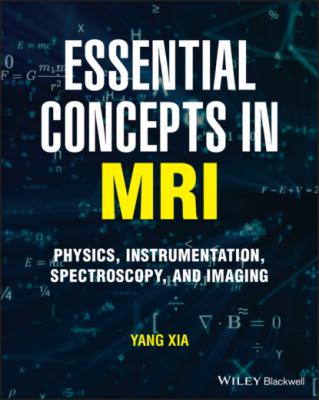ТОП просматриваемых книг сайта:
Essential Concepts in MRI. Yang Xia
Читать онлайн.Название Essential Concepts in MRI
Год выпуска 0
isbn 9781119798248
Автор произведения Yang Xia
Жанр Медицина
Издательство John Wiley & Sons Limited
1.4 THE ORGANIZATION FOR A ONE-SEMESTER COURSE
This book is written ultimately for those who are interested in MRI. It contains the four essential components of MRI (Figure 1.6): the theory of physics that is the foundation of this fascinating phenomenon (Part I) [1, 2, 18, 19], the fundamental instrumentation and experimental techniques that facilitate the execution of this phenomenon (Part II) [1, 20], and two main applications – NMR spectroscopy (Part III) [21, 22, 23] and MRI (Part IV and Part V) [2, 4, 24]. Although each of these components could be taught in great detail in one or two semesters, the goal of this book is to cover the essential concepts in all four components in a typical one-semester course, hence the title of the book begins with Essential. I trust that you would be well prepared when you need to explore any topic deeper. In addition to the numerous equations, there are about 190 figures in the book that provide the graphical descriptions for the concepts.
Figure 1.6 Major conceptual components of NMR and MRI.
For the theory, I first give you the classical description of NMR, since it is easy to understand and visualize and provides a very useful first approximation. (If your goal is to do MRI on water-rich samples, the classical description is mostly sufficient.) I’ll then describe NMR in a compact (i.e., abbreviated) quantum mechanical form, so that you will be at least familiar with the basic approach and terminology of the mathematical treatment.
Sandwiched between the fundamental theory and practical applications are the NMR instrumentation and experimental techniques (Part II), which facilitate the execution of this phenomenon. For these techniques, I discuss the basic unit of the NMR system. (The additional hardware in MRI is discussed in Chapter 13.) These get-your-hands-dirty discussions on hardware and experimental techniques will let you see behind the equations and behind the black box, to understand how the experiments are carried out and what are the practical issues in spectroscopy and imaging. Although the hardware knowledge will be described in terms of NMR and MRI, it should be useful in other modern technologies involving electronics, computer applications, signal acquisition, and imaging.
The description of NMR spectroscopy aims to supply you with basic knowledge of the topic, which is more than what you can find from any of the MRI books. I truly believe that for any MRI researchers and technical personnel, the knowledge of NMR spectroscopy is critically important. The last two parts (IV and V) cover modern practice in MRI, with an emphasis on quantitative imaging, which is at the center of modern MRI research and diagnostics.
This book can be adapted for a one-semester course in several different formats. For the students who major in science (physics, chemistry, material science, engineering), a course should include all four components of MRI (theory, instrumentation and experiment, spectroscopy, imaging). For this format, one can teach either at the undergraduate senior level or the graduate level. If the students are mainly interested in imaging, a course can be tailored toward MRI, with just a brief introduction to NMR spectroscopy. One can teach this version of the course to students in medical school. Appendix 4 has several sample syllabi for teaching.
References
1 1. Fukushima E, Roeder SBW. Experimental Pulse NMR: A Nuts and Bolts Approach. Reading, MA: Addison-Wesley; 1981.
2 2. Callaghan PT. Principles of Nuclear Magnetic Resonance Microscopy. Oxford: Oxford University Press; 1991.
3 3. Canet D. Nuclear Magnetic Resonance – Concepts and Methods. Chichester: John Wiley & Sons; 1996.
4 4. Haacke EM, Brown RW, Thompson MR, Venkatesan R. Magnetic Resonance Imaging: Physical Principles and Sequence Design. New York: Wiley-Liss; 1999.
5 5. Purcell EM, Torrey HC, Pound RV. Resonance Absorption by Nuclear Magnetic Moments in a Solid. Phys Rev. 1946; 69:37–8.
6 6. Bloch F, Hansen WW, Packard ME. Nuclear Induction. Phys Rev. 1946; 69:127.
7 7. Proctor WG, Yu FC. The Dependence of a Nuclear Magnetic Resonance Frequency upon Chemical Compound. Phys Rev. 1950; 77:717.
8 8. Dickinson WC. Dependence of the F19 Nuclear Resonance Position on Chemical Compound. Phys Rev. 1950; 77:736.
9 9. Arnold JT, Dharmatti SS, Packard ME. Chemical Effects on Nuclear Induction Signals from Organic Compounds. J Chem Phys. 1951; 19:507.
10 10. Hahn EL. Spin Echoes. Phys Rev. 1950; 80:580–94.
11 11. Lowe IJ, Norberg RE. Free-Induction Decays in Solids. Phys Rev. 1957; 107:46.
12 12. Ernst RR, Anderson WA. Application of Fourier Transform Spectroscopy to Magnetic Resonance. Rev Sci Instrum. 1966; 37(1):93–102.
13 13. Odeblad E, Lindström G. Some Preliminary Observations on the Proton Magnetic Resonance in Biologic Samples. Acta Radiol. 1955; 43(6):469–76.
14 14. Xia Y, Stilbs P. The First Study of Cartilage by Magnetic Resonance: A Historical Account. Cartilage. 2016; 7(4):293–7.
15 15. Lauterbur PC. Imaging Formation by Induced Local Interactions: Examples Employing Nuclear Magnetic Resonance. Nature. 1973; 242:190–1.
16 16. Johnson GA, Thompson MB, Gewalt SL, Hayes CE. Nuclear Magnetic Resonance Imaging at Microscopic Resolution. J Magn Reson. 1986; 68:129–37.
17 17. Eccles CD, Callaghan PT. High-Resolution Imaging: The NMR Microscope. J Magn Reson. 1986; 68:393–8.
18 18. Slichter CP. Principles of Magnetic Resonance. 3rd ed. Berlin: Springer-Verlag; 1992.
19 19. Hennel JW, Klinowski J. Fundamentals of Nuclear Magnetic Resonance. Essex: Longman Scientific & Technical; 1993.
20 20. Chen C-N, Hoult D. Biomedical Magnetic Resonance Technology. Bristol: Adam Hilger; 1989. 2436–8.
21 21. Harris RK. Nuclear Magnetic Resonance Spectroscopy – A Physicochemical View. Essex: Longman Scientific & Technical; 1983.
22 22. Bovey FA. Nuclear Magnetic Resonance Spectroscopy. 2nd ed. San Diego,

